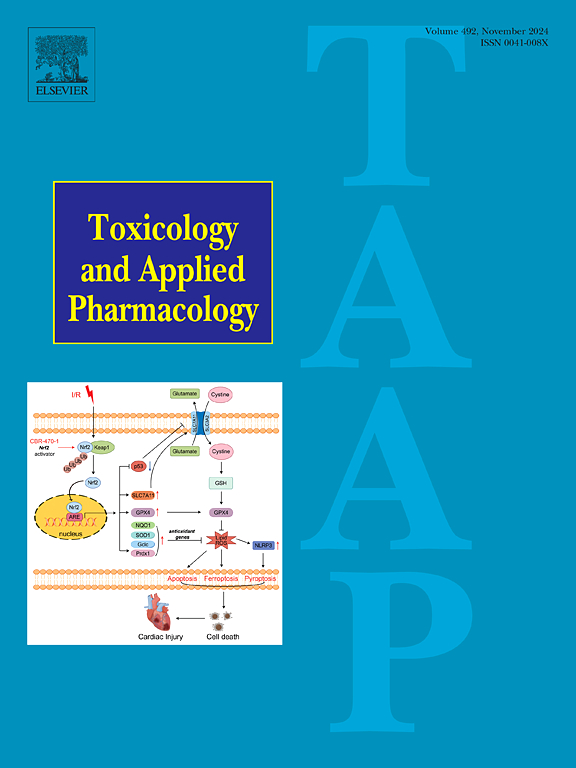The lipidome landscape of amiodarone toxicity: An in vivo lipid-centric multi-omics study
IF 3.3
3区 医学
Q2 PHARMACOLOGY & PHARMACY
引用次数: 0
Abstract
Amiodarone is an effective therapy for arrhythmias, its prolonged management may lead to significant adverse drug reactions. Amiodarone-induced hepatotoxicity is described by phospholipidosis, hepatic steatosis, cholestatic hepatitis, and cirrhosis. However, the systemic and hepatic lipidome disturbances and underlying toxicological mechanisms remain comprehensively elucidated. Untargeted lipidomics were utilized to analyze serum and liver samples from the rats orally administered a daily dose of amiodarone of either 100 or 300 mg/kg for one week. Changes in the expression of hepatic lipid-related genes were also examined utilizing transcriptomics. We found a higher magnitude of lipidome alterations in the 300 mg/kg than those in the 100 mg/kg groups. Treated animals showed elevated abundances of phosphatidylcholines, ether-linked phosphatidylcholines, sphingomyelins, and ceramides, and decreased levels of triacylglycerols, ether-linked triacylglycerols, and fatty acids. We also found 199 lipid-related differentially expressed hepatic genes between the 300 mg/kg group versus controls, implying lipid metabolism and signaling pathways disturbances. Specifically, elevation of serum phosphatidylcholines and ether-linked phosphatidylcholines, as well as hepatic bismonoacylglycerophosphates might be associated with reduced expression of phospholipase genes and elevated expression of glycerophospholipid biosynthesis genes, possibly driving phospholipidosis. Perturbations of sphingolipid metabolism might also be the key events for amiodarone-induced toxicity. Alterations in gene expression levels related to lipid storage and metabolism, mitochondria functions, and energy homeostasis were also found. Collectively, our study characterized the sophisticated perturbations in the lipidome and transcriptome of amiodarone-treated rats and suggested potential mechanisms responsible for amiodarone-induced hepatotoxicity.

胺碘酮毒性的脂质体景观:一项以脂质为中心的体内多组学研究
胺碘酮是治疗心律失常的有效药物,但长期使用可能导致严重的药物不良反应。胺碘酮引起的肝毒性表现为磷脂病、肝脂肪变性、胆汁淤积性肝炎和肝硬化。然而,系统性和肝脏脂质紊乱及其潜在的毒理学机制仍有待全面阐明。使用非靶向脂质组学分析了每天口服100或300 mg/kg胺碘酮一周的大鼠的血清和肝脏样本。我们还利用转录组学检测了肝脂质相关基因表达的变化。我们发现300 mg/kg组的脂质组改变幅度高于100 mg/kg组。经治疗的动物显示磷脂酰胆碱、醚连接磷脂酰胆碱、鞘磷脂和神经酰胺的丰度升高,甘油三酯、醚连接甘油三酯和脂肪酸的水平降低。我们还发现,与对照组相比,300 mg/kg组有199个脂质相关的肝脏基因表达差异,这意味着脂质代谢和信号通路受到干扰。具体而言,血清磷脂酰胆碱和醚连接磷脂酰胆碱以及肝脏甘油磷酸铋的升高可能与磷脂酶基因表达减少和甘油磷脂生物合成基因表达升高有关,可能导致磷脂病。神经鞘脂代谢的紊乱也可能是胺碘酮引起毒性的关键事件。与脂质储存和代谢、线粒体功能和能量稳态相关的基因表达水平也发生了变化。总的来说,我们的研究描述了胺碘酮治疗大鼠的脂质组和转录组的复杂扰动,并提出了胺碘酮诱导肝毒性的潜在机制。
本文章由计算机程序翻译,如有差异,请以英文原文为准。
求助全文
约1分钟内获得全文
求助全文
来源期刊
CiteScore
6.80
自引率
2.60%
发文量
309
审稿时长
32 days
期刊介绍:
Toxicology and Applied Pharmacology publishes original scientific research of relevance to animals or humans pertaining to the action of chemicals, drugs, or chemically-defined natural products.
Regular articles address mechanistic approaches to physiological, pharmacologic, biochemical, cellular, or molecular understanding of toxicologic/pathologic lesions and to methods used to describe these responses. Safety Science articles address outstanding state-of-the-art preclinical and human translational characterization of drug and chemical safety employing cutting-edge science. Highly significant Regulatory Safety Science articles will also be considered in this category. Papers concerned with alternatives to the use of experimental animals are encouraged.
Short articles report on high impact studies of broad interest to readers of TAAP that would benefit from rapid publication. These articles should contain no more than a combined total of four figures and tables. Authors should include in their cover letter the justification for consideration of their manuscript as a short article.

 求助内容:
求助内容: 应助结果提醒方式:
应助结果提醒方式:


